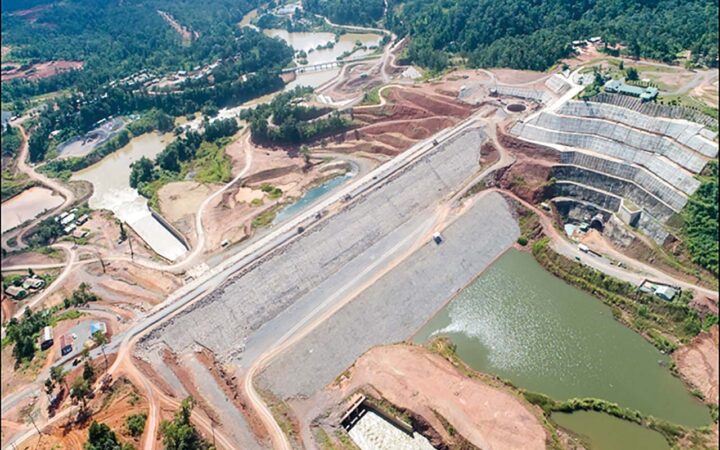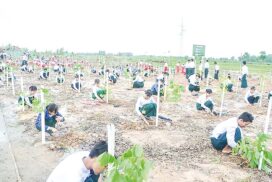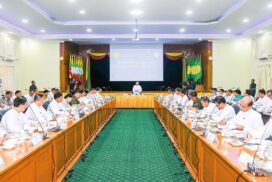The Construction Task Force No.5 under the Department of Hydropower Implementation has been constructing the Upper Kengtawng Hydropower Plant near Kengtawng Town in Shan State (South). The power plant may fulfil both the State’s and the country’s electricity demand by harnessing the power of Namteng Creek.
The project has an installation capacity of 51 megawatts with three 17-MW power stations. The electricity produced from the power plant will be transmitted through the national grid by connecting the Namsam Main Power Sub-station via the 230-kV power grid.
U Toe Lwin, director of the Department of Hydropower Implementation at the Ministry of Electric Power, said: “We’d finished 80.52 per cent of the project by October 2023. We’ll try to finish it by the end of the financial year 2024-25. We’re trying our best since it can supply our country’s much-needed electricity demand.”
The department successfully constructed the 54-MW Kengtawng Hydropower Plant on 26 March 2009.
During the construction of the Kengtawng Hydropower Plant back in 2006, the department’s engineers conducted an initial survey with experts from the Japan-based Kansai Co Inc to build another power plant on the Namteng Creek.
Moreover, the engineers and specialists from the Switzerland-based Colenco Power Engineering Co Ltd studied locations for hydro-powered structures, geological features and quality of construction materials for the Upper Kengtawng Hydropower project in 2009.
Similarly, the Japanese NEWJEC and the Norwegian Nor-Consult/Multi-Consult cooperated with the department in building access roads and staff accommodations by producing blueprints and conducting detailed measurements.
The director added: “We collaborated with specialists from Japan, Switzerland and Norway for the early initiative. We’re working, but our homegrown engineers carry out the technical and construction works.”
The dam installed in the Upper Kengtawng project is 1,800 feet long and 230 feet tall. It’s a zone-type pebble-filled earthen dam, and all the materials, including rocks and sand used in a barrier, underwent rigorous scrutiny to ensure the highest quality.
The main dam was finished in November 2021. To channel water to the power station, the engineers excavated an underground tunnel with a length of 1,726 feet and a diameter of 26 feet.
So far, every component of the hydropower infrastructure has been built except the high-pressure steel pipeline, power station and sub-station.
To deliver the necessary water volume to the power plant, a vertical conduit with a diameter of 82 feet and a length of 151 feet is being constructed in connection with the tunnel. The civil engineering aspects are completed, and the engineers assemble the gate.
The water stored in the main dam will drive the power stations. To manage excess water during the rainy season, a 460-foot-wide spillway, designed as a Labyrinth Type Weir and the first of its kind in Myanmar, has been constructed. The engineers are currently applying the finishing touches.
Only the high-pressure steel pipe connecting the power station and sub-station is left to be done. The department has procured essential electrical equipment through a contract with the China-based Consortium of DEIC & GF. Approximately 50 per cent of the equipment has been successfully delivered.
The department has meticulously selected projects with minimal environmental and social impacts. The Upper Kengtawng Hydropower Project, with a storage capacity of 104,000 acre-feet, has a low potential for adverse impact. The project is expected to improve the quality of life for the local population.
Resident U Sai Ponnya supported the project: “When the Upper Kengtawng Hydropower Project is done, we’ll have two hydropower plants here. They’ll enable us to use electricity 24 hours a day. Thanks to this, our towns have become much more developed.”
Since electric power plays a crucial role in building a developed country, the department strives to finish the project by the end of the financial year 2024-25.
Upon completion, the two hydropower plants will collectively generate 267 million kilowatt-hours annually, capable of supplying electricity to about 700,000 people connected to the main grid.
The project can serve the residents of Loilem, Namhsan, and Langkho districts and supply surplus electricity to the broader public via the main grid. Undoubtedly, this initiative is poised to benefit the people through illumination.
Translated by NT














